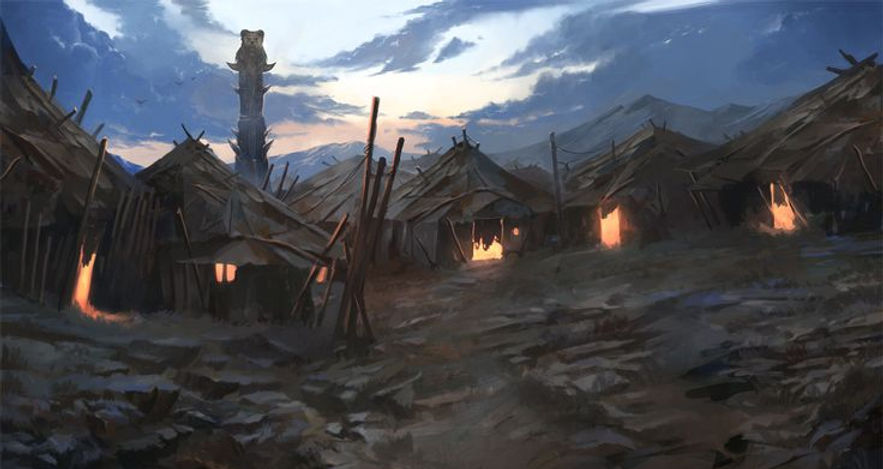

The Old Gods
The Old Gods are not creators. Even the people of ancient Tevinter attributed the creation of the world to a Maker-like deity, although by a different name, far before the Andrastian faith began.
Instead, the Old Gods were revered as immensely powerful beings, embodying specifics aspects of existence and commanding influence over mortal lives because of it. Their names are invoked for specific circumstances, each draconic entity able to grant blessings, wisdoms, and power, or bring ruin if displeased.
With the rise of Andraste and the Chantry, worship of these dragons has diminished significantly. The Old Gods linger primarily among those in Tevinter and certain tribes in Ferelden. Those in Ferelden may have aided Andraste, but now see her influence as twisted to the whims of foreign powers attempting to assert control, rather than divine.
History
Before the rise of the Chantry, humanity in Thedas worshipped seven great draconic beings known collectively as the Old Gods. Emerging in ancient Tevinter, their worship became deeply embedded into the empire's cultural and spiritual identity, with each Old God presiding over specific aspects of mortal existence. Temples and statues were built in their honor, solidifying their influence over Tevinter's society and its mageocracy.
However, the Old Gods were never seen as creators; even ancient Tevinter attributed the creation of the world to a deity similar to the Maker, known by other names. The Old Gods' power stemmed instead from their perceived control over mortal lives and their dominion over the spiritual and mystical realms. Over centuries, worship evolved, with magisters invoking them through elaborate rituals and ceremonies, believing these beings granted profound magical power, insights, and dominance.
Their prominence dramatically declined following the catastrophe at the Golden City, when Tevinter magisters—supposedly guided by whispers from the Old Gods—entered the Fade, resulting in the corruption of the Golden City into the Black City. Blamed for this calamity, the Old Gods were sealed beneath the earth, their worship suppressed and stigmatized. With the martyrdom of Andraste and the rise of the Chantry, their reverence was systematically dismantled, labeled as heresy.
Altus, barbarian tribes, hidden cults, scholars, mages, all sorts preserve fragments of ceremony dedicated to the Old Gods. The Chantry has usurped the foundation of the Old Gods, the Blight given a source to blame and the Imperium's magisters further ridiculed for it.
The Chantry teaches that when the Maker turned his back on spirits, some of them grew jealous of the living. Those powerful enough whispered to the living in dreams claiming that they were the true gods, the creators of the world and the living should bow down before them.
Eventually, the living summoned them through the Veil. In the mortal realm, these spirits took the form of dragons, winged Old Gods that ruled over the land. The living started to worship them instead of the Maker, an act recognized as the "Original Sin". In fury, the Maker cursed the Old Gods, imprisoning them in underground tombs where they would slumber eternally.

We dreamed up false gods, great demons
Who could cross the Veil into the waking world,
Turned our devotion upon them, and forgot you.

The demons who would be gods,
Began to whisper to men from their tombs within the earth.
And the men of Tevinter heard and raised altars
To the pretender-gods once more
Core Beliefs
Many still worship seven Old Gods. The first—and the leader of the others—was called Dumat, the Dragon of Silence.
-
Dumat, the Dragon of Silence. Dumat was the most powerful among the Old Gods. Those educated, Grey Wardens, or Chantry worshippers know that the Archdemon of the Blight was the risen Old God Dumat.
-
Zazikel, the Dragon of Chaos. They are often times called the Dragon of Freedom, but overall Zazikel is called upon in times of unpredictability or by those breaking tradition.
-
Toth, the Dragon of Fire. A representation of passion, Toth is often invoked by artists, poets, or mages seeking inspiration.
-
Andoral, the Dragon of Slaves. They embody discipline and order and are called upon for control of will.
-
Urthemiel, the Dragon of Beauty. Symbolic of more refined aspects, their guidance is sought for ceremonies, architecture, and fashion.
-
Razikale, the Dragon of Mystery. The personification of forbidden knowledge, they are for those who seek hidden insights or wisdom.
-
Lusacan, the Dragon of Night. Embodying darkness itself, dreamers, and mystics favor Lusacan, as do thieves, assassins, and rumors say that even Werewolves covet their favor.

